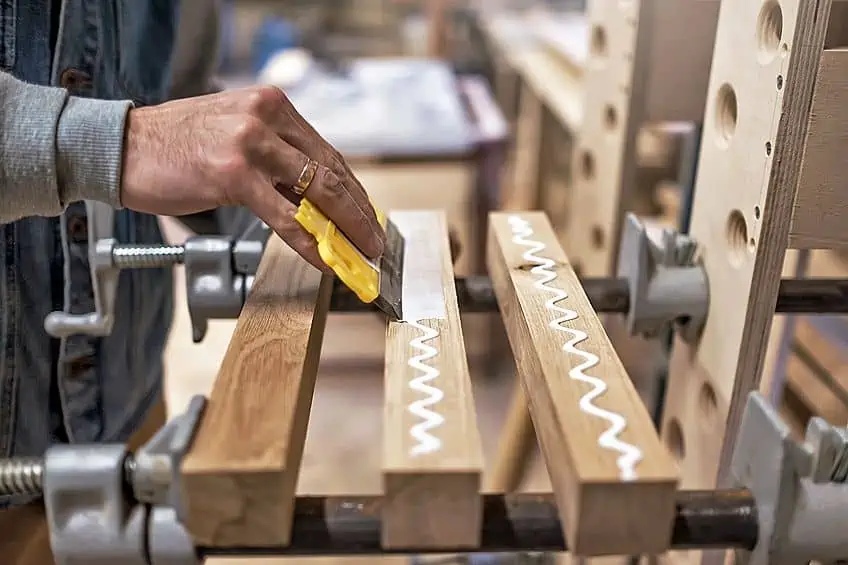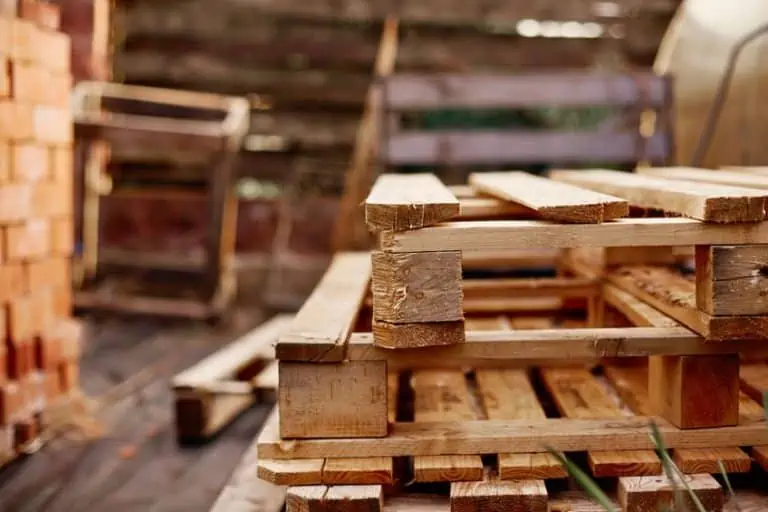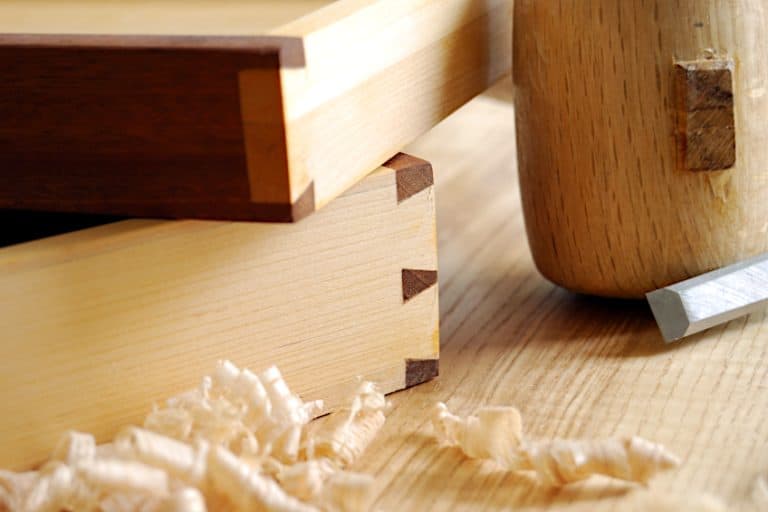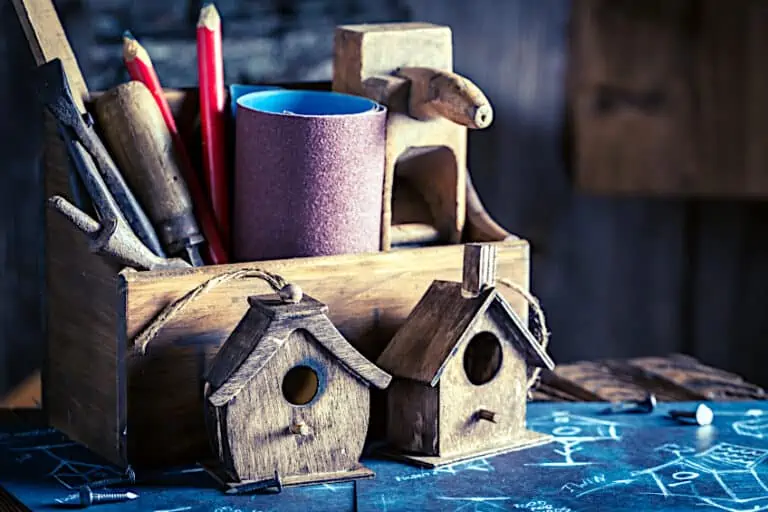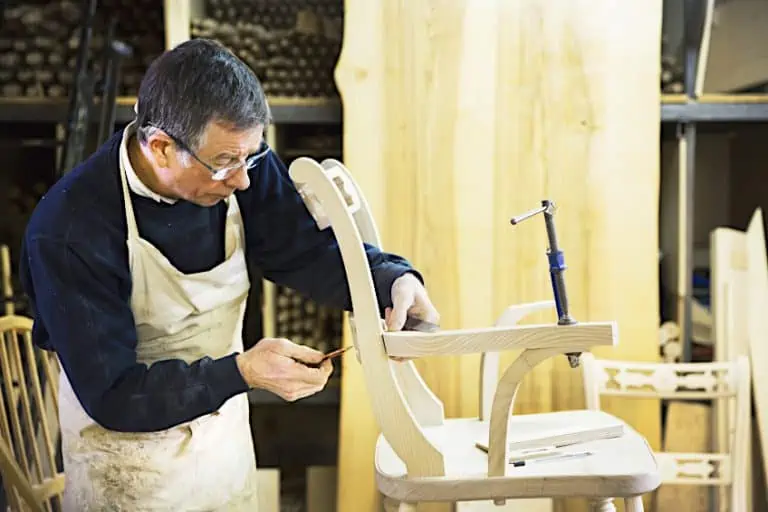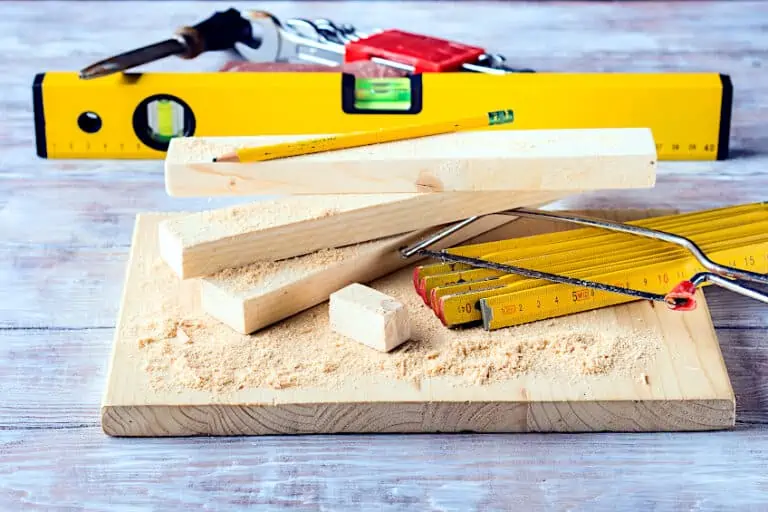Types of Wood Glue – Looking at the Strongest Glues for Wood
When working with wood, you may often find yourself needing to adhere two pieces of wood together or bond wood with another material. One option to achieve this is to use a wood glue. There is an assortment of wood glue options available on the market. This guide will assist you in understanding the properties of wood glue and help you to select the ideal product for your project.
Properties of Wood
Before combining glue and wood, you need to take into consideration a few things, particularly as no two types of wood are the same. There are a variety of woods that you can distinguish by several factors, such as the color of the wood, the probability of existing resin ducts, and the hardness of the wood. You need to determine if the wood is porous or swelling, or if it is a solid wood, such as sapwood, heartwood, or chipboard.
You also need to keep in mind that the properties of the wood can vary depending on different elements, such as environmental conditions, humidity, and temperature. Wood can be described as ‘working’ in that it contracts and expands in response to these elements. Over time, this working can cause glued seams to be damaged – and in some severe cases crack – if the incorrect adhesive has been used.
A good quality adhesive should be able to bond different materials together, particularly when different coefficients of thermal expansions are present. It is imperative to take all aspects into account when selecting a wood glue, as the glue needs to offer good adhesion while ensuring that the wood does not absorb the glue or cause the wood to swell.
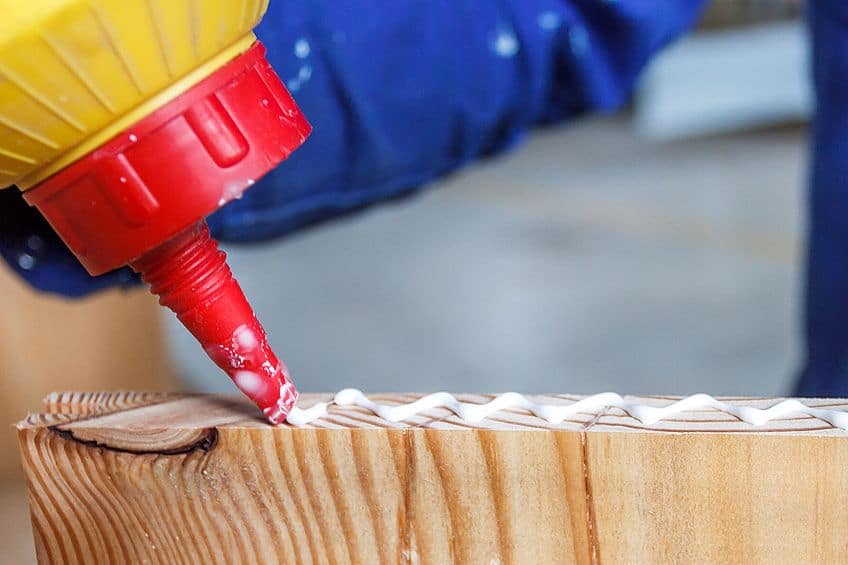
Overview of Different Wood Glue Stress Groups
The adhesive needs to have the optimal properties that will ensure the wood joins permanently and with great strength. Because of this, wood adhesives are divided into four groups of how much stress they are able to endure. Wood glue is more durable when it has a higher stress class designation.
It is imperative to pay attention to the stress group when you wish to glue wood, or you might find that your glued seam is not sufficient when exposed to bad weather conditions outside. Theoretically, all stress groups are good for indoor projects, but only D4 offers you a strong adhesive bond outside.
If you are tackling an outside project, you will also need to take into consideration the wood glue’s temperature resistance. White glue, for example, is great in terms of compensation for direct sunlight and vast temperature differences. The stress group classes are D1, D2, D3, and D4:
| STRESS GROUP D1 | STRESS GROUP D2 | STRESS GROUP D3 | STRESS GROUP D4 |
|
|
|
|
Different Types of Glue for Wood
There are a variety of wood glues available for purchase, but not all of them can be used on every project; some can be used indoors and some for outside projects. There are also other criteria you need to take into consideration, however, such as whether the wood glue is made from synthetic substances or natural ingredients. There are two types of natural glue, both of which are environmentally friendly and food-safe. But as glue, they are more suited for professional crafts as opposed to home use, and are therefore harder to come by for purchase. The two types are:
- Casein glue: This is made up of a milk protein called casein, and is produced in combination with calcium hydroxide (i.e. slaked lime).
- Glutin glue: This is only used in exceptional cases, and contains animal waste materials (i.e. bones)
Unlike glutin glue, casein glue is heat- and water-resistant, but it is mainly used by the likes of carpenters as opposed to do-it-yourselfers.
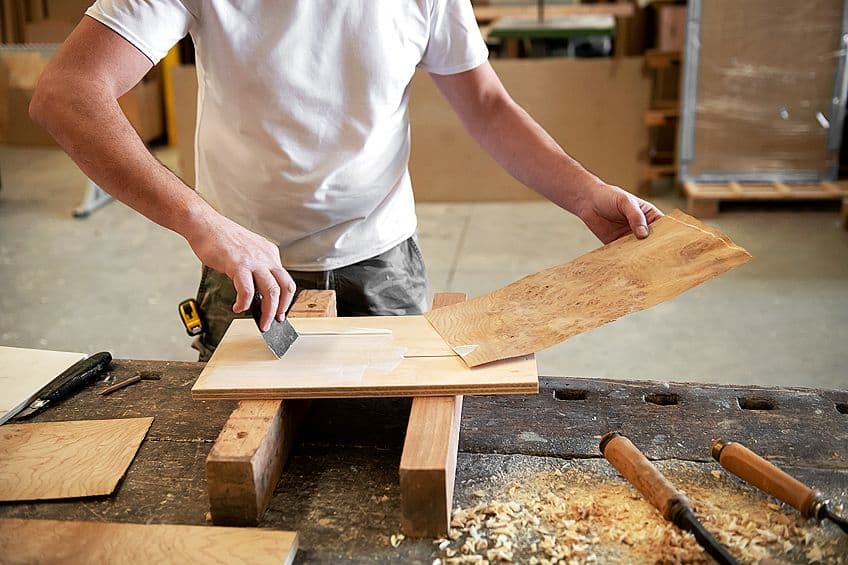
Alternatively, synthetic ingredients can also be used for wood glue. These are normally dispersion adhesives, and therefore do not have solvents or formaldehyde. That being said, there are glues available that are formaldehyde glues, as well as epoxy resin adhesives and polyurethane glues. The most commonly known and used synthetic wood glue is that of white glue.
There are many advantages to synthetic wood glues, such as the fact that they can withstand high loads and can bond together with an assortment of materials. However, it is still important to pay attention to the D1 to D4 classifications. Synthetic wood glues are also readily available on the market.
Keep in mind, however, that they too have their disadvantages, such as the harmful chemical components they are made of. These chemicals can give off a terrible smell when you are working with the glues and can negatively impact the user’s health. You must wear the necessary safety equipment when you are working with synthetic glues.
White Glue (PVA Wood Glue)
PVA wood glue is commonly referred to as white glue, as before it cures, it is a white, milky color. However, once cured, it is transparent in color, providing a very inconspicuous line of glue. You will not have to mix white glue in any specific way, and you do not have to thin it out at all, although you can combine it with a curing agent or a crosslinker if desired. If you are working with a wood that contains oil or a resin, such as tropical woods or hardwoods, the bonding process with the white glue can be impaired.
PROS
- As a wood glue, it creates a strong bond
- Odorless as it is formaldehyde-free
- Cures quickly at room temperature
- Once cured is transparent in color, making it inconspicuous
CONS
- Shouldn’t be used with hardwoods or tropical woods
- The majority of white glues are not food-safe
- Certain PVA wood glues are not waterproof
Recommended White Glue: ELMER’s Carpenter’s Wood Glue
Elmer’s wood glue provides a bond that is even stronger than wood. As a white glue, it gives off no chemical fumes and is non-toxic, and can be cleaned up simply with the use of water. This wood glue is resistant to mildew, heat, mold, and water, making it one of the strongest wood glues available. It can also be used both inside and outside.
Once the glue has cured, you can sand, stain, and paint the adhesive without damaging the integrity of the glue. Elmer’s wood glue takes roughly 24 hours to fully cure, and users have found that the nozzle tends to become clogged up with leftover dried glue, although these are the only real disadvantages to this glue. The manufacturers believe so strongly in the product that they claim that the wood will break before the bond does!
Polyurethane Glue for Wood
Polyurethane glue is the best modern-day version of wood glue, ensuring that the majority of surfaces are bonded together permanently and safely. These glues are very water-resistant and free of any solvents, and are great for use on outdoor projects, including wooden items. Polyurethane glues work well in spite of unstable weather conditions, thanks to their being a waterproof glue.
You can purchase polyurethane glues in either two- or one-component formulas, where either option will cure flexibly and elastically. These glues are great for bonding different substances or materials, even if the materials are exposed to high levels of vibrations or have different coefficients of thermal expansion. The largest difference between the two- and one-component glue is that the two-component option only requires 24 hours to cure and has a limited pot life, while the one-component glue takes up to three days to completely cure.
PROS
- Weatherproof and can be used outside
- Can be purchased as either a two- or one-component adhesive, each with its own bonding properties
- Compatible with an assortment of materials
- Very resistant to weather conditions and environmental factors
- An ideal choice for bonding large surface areas
- Ages well
- Extremely high gap-bridging capacity
- Adhesion seam can withstand high loads thanks to optimal structural strength
CONS
- Relatively expensive
- Due to the short pot life, better suited for experienced craftsman who can work quickly
Recommended Polyurethane Glue: LOCTITE Premium Polyurethane Construction Adhesive
This is a safe and easy-to-use polyurethane-based adhesive that can be used on both outdoor and indoor projects. Loctite promises that the adhesive will last as long as the surface to which you have applied it, as the glue is eight times stronger than the majority of other construction-grade adhesives available to purchase.
This product will cure regardless of how cold the temperature is, and as it is VOC-compliant, it is a great choice for adhering your wooden surfaces. When the glue has completely cured, you are even able to paint over it, which is a great advantage. This polyurethane glue can be used on almost any surface, but is not suggested for use on non-porous surfaces.
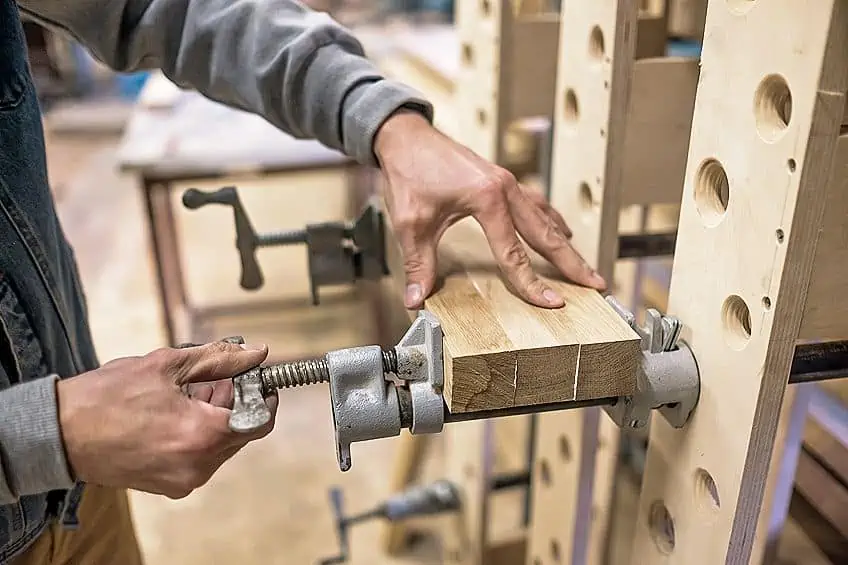
Epoxy Wood Glue
Epoxy wood glue is a great option for wood glue as it creates a resilient bond and is highly durable. Epoxy wood glue is made up of two components, being a liquid hardener and resin, and therefore fall into the category of reactive adhesives, as they require a chemical reaction for the curing process to take place. Epoxy glues are very resilient to chemical influences and are resistant to mechanical influences as well. This is a waterproof form of wood glue that can be used both as a gap filler and as a wood adhesive.
PROS
- Specific measurements and time ranges so that you know when the adhesive has cured
- Creates a highly resilient, strong, and durable bond
- Filler materials such as accelerators, color pigments, or inhibitors can be added
- Bonds an assortment of materials such as ceramics, wood, concrete, inhibitors, or color pigments
- Solvent-free
- Resistant to several mechanical influences and also aggressive substances and oils
CONS
- Harmful fumes are given off by epoxy in its liquid state, so you must wear protective equipment and clothing
- Very expensive
- Not easy to mix; you have to ensure the mixing ratio is correct
Recommended Epoxy Wood Glue: GORILLA Two-Part Epoxy Syringe
This two-part wood glue epoxy is lasting, durable, and can be used as a gap-filler. You can use it on any surfaces that require a durable and strong bond. It dries clear in color and sets quickly, and the syringe-like packaging makes it is easy to apply. The Gorilla epoxy syringe has two separate barrels, one of which contains a hardener and the other a resin. The separate barrels stop the two components from combining, preventing the chemical reaction that causes hardening from occurring.
You start by dispensing equal amounts from each tube and then mixing the two components together, being sure to mix sufficiently. You then can apply the epoxy glue, although you only have five minutes to do so before it begins to harden. Once applied, allow the epoxy to cure for 24 hours so as to ensure a lasting and tough bond. One disadvantage to this product is that it can be difficult to gauge equal amounts of the two components when dispensing them from the respective barrels.
Superglue
Superglue (also known as cyanoacrylate adhesive) is an instant adhesive that is ideal for selective and small bonding. You cannot use it over large surface areas as it has a very short curing time. When fixing is impossible, you can use superglue as an alternative bonding agent.
PROS
- An assortment of superglues of different consistencies are available on the market
- Permanent and firm connections are possible
- Dispensing tips are available in different sizes
- Can be used on many different materials
- Ideal for quick work
CONS
- Cannot be used over a large surface area due to a short pot life
- Due to the short curing time, skin contact must be avoided at all costs
Recommended Superglue: GLUE MASTERS Professional-Grade Cyanoacrylate Superglue
Offering one of the strongest wood glue alternatives, with a long shelf life, a nozzle that doesn’t jam or clog, and the ability to cure almost immediately this is a premium-grade superglue. Curing in only 15 seconds this medium-bodied superglue shows how a little goes a long way. The nozzle makes the glue ideal for detailed projects as it offers an even flow and allows for precision application. The glue can be used on almost any surface, except clothing or fabric.
When using this superglue ensure you are working in a well-ventilated area as it is a very toxic substance. Despite the viscosity being quite thin, this is a high-quality and effective superglue.
Gluing Wood to Other Materials
You do not have to glue wood only to wood; you can use glue to bond wood to an assortment of materials, including tile, metal, concrete, and glass. To select the correct glue when bonding wood to other materials, you need to take both materials’ properties into consideration.
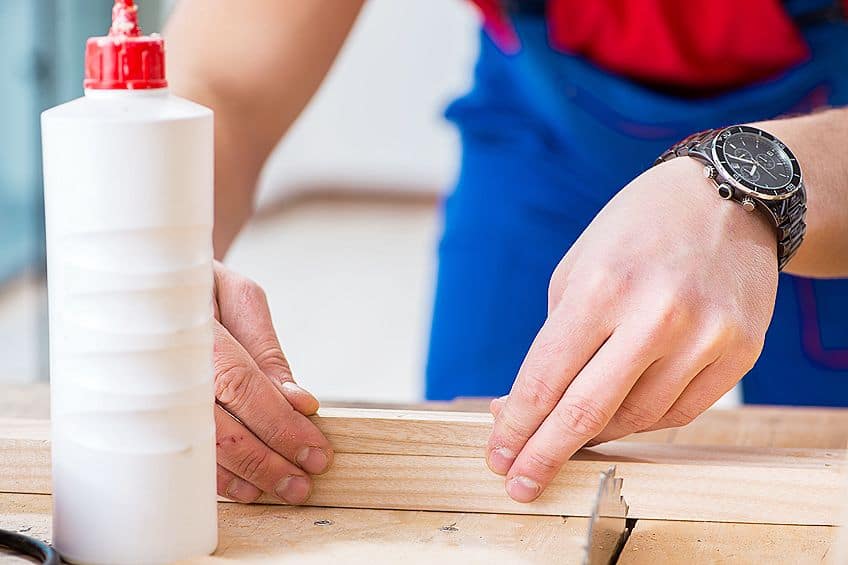
Gluing Wood to Concrete
As someone who likes to tackle DIY projects, you will find many situations where you wish to glue concrete and wood together, which can be done using a solid assembly adhesive. Apply the adhesive with wavy lines and in the shape of a beard. This ensures that no air pockets form and that the glue spreads optimally to guarantee adequate bonding. Be careful not to apply the glue too thinly to compensate for any cracks or odd spots.
Gluing Glass to Wood
The main problem when attempting to bond glass and wood is that glass is an immobile material and very smooth, while wood is porous. Stress can occur after bonding the two materials, as wood does not work like glass. Because of these factors, it is important to select the correct glue when attempting to bond wood and glass.
Clear glass is particularly troublesome, as all glues leave streaks on the glass, even if you are using a transparent adhesive. If you are working with coated glass, you run the risk of the coating coming away from the glass, which is another element you need to take into consideration.
You should always test out the adhesive on an inconspicuous area of the glass before you apply the glue to any larger areas.
If you are working with coated glass, your go-to is that of a mounting adhesive. If you are working with clear glass, you will require a transparent adhesive. This form of glue allows for compensation in the contraction and expansion of the wood, as the glue is still flexible once it has cured. Another option when bonding wood to glass is to use a two-component adhesive.
Gluing wood and Tiles Together
Gluing tiles directly to wood is not ideal, as wood ‘works’ in that it expands and contracts depending on humidity and temperature. Tiles, on the other hand, do not compensate for the movement of wood. The movement creates tension that can inevitably lead to the tiles cracking. How to compensate for this is to use decoupling mats. To use these, you would glue the decoupling mats to the wooden surface, and then lay the tiles on top using tile adhesive.
Glue for Metal and Wood Bonding
It is possible to bond wood and metal as long as you work carefully and use the correct adhesive. If you do not use the correct adhesive, you run the risk of cracking the top layer of the wood, as the metal has greater internal strength than any wood. We suggest that you use an acrylic adhesive or a two-component epoxy resin adhesive. Also, keep in mind that there are many different metals, each with their own properties, meaning that not all metals can be bonded well to wood.
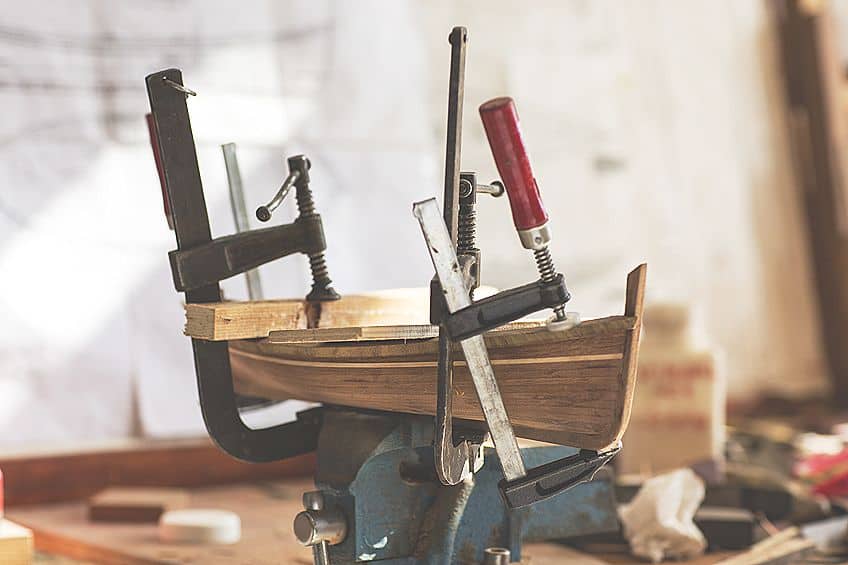
How to Use Glue for Wood
Gluing wood can be done by beginners and professionals alike, but you will need to take some aspects into consideration. By following our step-by-step instructions, you will find it easy to work with gluing wood.
Preparatory Work
- Before you begin gluing anything, you will need to prepare the surface. This is important so as to ensure the durability of the adhesion seam. Make sure that you clean the substrate of any dirt, rust, or grease.
- Ensure the surface is completely flat. This can be achieved through grinding, planing, and sanding the surface. When evening out the surface, you must also ensure that you remove any old paint as well. Remember to clean away any leftover dust once you are done.
- Next, using diluted wood glue, you must prime the surface. This is necessary in order to ensure that the wood glue is not completely taken in by any absorbent surfaces.
- By diluting the glue and applying it to the surface, you are priming the adhesive surface area. Allow this primer to dry completely before you begin the actual gluing process.
The Gluing Process
- Apply wood glue to both sides of the substrates. Be generous, but not so much so that the glue oozes.
- Put the two substrates together and move them lightly back and forth to release any air bubbles. Once the air bubbles have been released, fix the two substrates in place.
- If there is any excess glue, use a wooden spatula to scrape it away. You can get rid of any final remnants by wiping them away with a damp cloth.
Loading of Joints and Curing
The length of time that is required for the wood glue to cure depends on the product you are using. We suggest that you consult the manufacturer’s datasheet and then, to be on the safe side, allow it to cure a little longer than advised. Leave the glued substrates in place until they have completely cured.
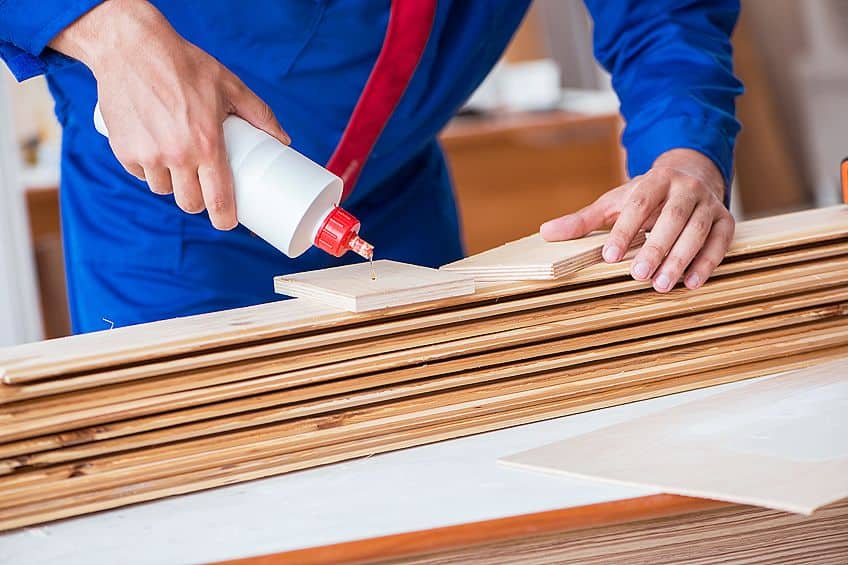
Removing Glue from Wood
When removing glue from wood, you need to determine if the wood is untreated or treated. If the wood is untreated, follow these steps to remove the glue:
- Take a lint-free cloth and apply acetone-free nail polish remover to it. Rub the cloth over the wood glue until it is removed.
- Alternatively, you can choose to sand down the wood using a steel sponge, steel wool, or sandpaper. Be careful that you do not damage the wood
If you need to remove glue from treated wood, it can prove to be a little more difficult. You can follow these steps:
- Use a hairdryer to heat the adhesive with care, ensuring that you do not damage the finish of the wood. Use the hairdryer on a low setting and aim the hairdryer at the area of adhesive for several minutes at a 20 cm distance, being sure that you do not linger on any single spot for too long.
- Frequently check if the heating of the adhesive is complete, as you should simply be able to pick up the glue with a paper towel. If the glue still does not come loose, try turning the hair dryer up to a slightly higher heat and attempt to heat the glue again
- You can also use a stove scraper to remove the wood glue, but this is something that can potentially damage the wood’s varnish.
It is not easy to simply bond wood to other materials, as each material has its own properties. Thus, using the incorrect adhesive can cause problems. Hopefully, this guide will help you in bonding wood to an assortment of materials.
Frequently Asked Questions
What Adheres to Wood?
Theoretically, wood can be bonded to any material, but you will need to use the correct adhesive and take into consideration the coefficient of heat and whether the material is porous.
How Long Does the Best Glue for Wood Last?
As one of the most durable adhesives, wood glue is your go-to. Ensure that your wood glue is stored in a closed container and protected from any direct sunlight or heat, and then your glue should last for years.
Which Is the Best Glue to Use for Stone and Wood?
You will need a high-quality assembly adhesive or a solid polyurethane adhesive to bond stone to wood. You need to take the gap-bridging properties of your selected adhesive into consideration, particularly when it comes to natural stone.
Which is the Best Glue to Use for Metal and Wood?
You will need a polyurethane adhesive or a two-component epoxy resin adhesive to bond wood and metal. The priority is for the adhesive to be able to compensate for the differences in the internal strengths of the two substances.

I have been into woodworking since 2005 and woodturning since 2011. Because of my love for wood and woodworking, I started woodhappen.com to teach other enthusiasts about how to finish and seal wood, the best woodworking tools, the different types of wood, and everything else related to woodworking! Read more about me here.

